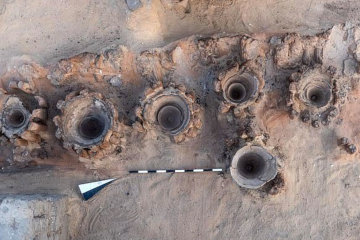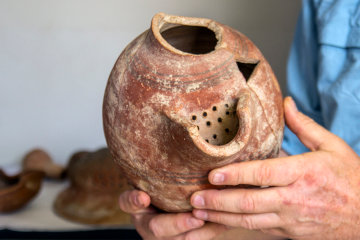The Brewery at Abydos
The recent discovery in Abydos by a joint American and Egyptian team of archaeologists of an ancient brewery is interesting for a number of reasons.

| |
| A general overview of the site of the newly discovered brewery in Abydos. |
The first is that reference to the Abydos brewery was first noted by British archaeologists in the early years of the Twentieth Century, but the location of the facility was not determined. No doubt Dr Matthew Adams, a leader of the expedition, is feeling very pleased with himself for having confirmed that the brewery was real and not just the daydream of some ancient Egyptian who liked his tipple.
The second reason is that Dr Adams has declared that the beer was used in royal burial rituals. Archaeologists have this curious penchant for seeing a ritual significance in everything they find, which does lead them to some remarkably silly conclusions. Given that the brewery could produce 22,400 litres in each production cycle - there were 8 sections or departments in the factory, each containing 40 large pots big enough to contain 70 litres of beer each - and given that pharaohs did not die all that terribly often, there must have been an awful lot of surplus beer poured down the drain just about every day! Either that, or some terribly drunk mummies lurking in the royal tombs!

| |
| Some of the large jars used for producing beer. There were 40 such jars in each sector of the brewery |
Abydos was a large and important religious and pilgrimage centre and as modern experience shows, there is nothing like a thirsty pilgrim for shifting the stuff! It is entirely possible that when a pharaoh died and came to be buried, the newly discovered brewery went into overtime producing enough beer for the funeral feast. It is also possible - or even likely - that the mortuary priests popped in every day or so to purchase a couple of jars to be placed in the graves of pharaohs like Narmer. The rest? Well, Egypt is a hot country and I don't suppose the priests were above sitting down at the end of a long day of chanting and indulging in a bit of liquid refreshment - assuming that the labourers in the fields, the scribes from the temples, and the flocks of pilgrims, had left them any!
This may be the biggest, but it is not the first Egyptian-style brewery to be discovered. In 2015 the Israeli Antiquities Authority announced that a rescue dig on a Tel Aviv building site had uncovered fragments of pottery from an Egyptian brewery, probably set up to supply thirsty Egyptian soldiers keeping the peace in Egypt's empire.
As far back as 1929 the German scholar Johannes Gruss examined the residue from an amphora dating back to 2,000 BC and discovered the Egyptians didn't simply soak bread in water and allow it to ferment, as some had theorised. They actually sprouted grains, which is one of the steps in producing a malted beer, evidence that Egyptian brewers were quite sophisticated in their production methods.

| |
| A strainer-jug found at Tel es-Safita, ancient Gath. |
And, of course, beer-related objects are well-known. One of the best known is the so-called "strainer jug" or cup. This is a pottery vessel with a spout which has a number of holes pierced through the wall of the vessel. Ancient brewers produced a liquid in which grain and straw floated, which must have detracted from the drinking experience. You therefore had your pint poured into a strainer vessel and drank from the spout. The holes in the wall held back the extraneous objects, allowing the beer to slip smoothly down your throat.
Recently scientists from several Israeli universities cooperated to brew ancient beer. They scraped the interior of some of these strainer vessels and were able to use DNA sequencing to identify the grains used in producing the beer. To their surprise, they also found yeast cells which, when put into a suitable medium, came back to life and multiplied. From 21 different vessels they found six different yeast strains; the oldest dated back to the time of Pharaoh Narmer while the youngest was from from the Persian period, the time of Nehemiah.
Using the information gained, the researchers were able to brew genuine ancient beer. They report that the drink was "not bad" and expressed satisfaction that they were able to "taste the flavours of the past".
Which brings us to the third interesting thing. Although beer strainers have been found all over Palestine, if you conduct a search of your KJV Bible, there is not a single reference to beer. Wine - lots of references; but not a single mention of what was clearly an important drink. However what you will frequently find paired with "wine" is the term "strong drink".
In our modern world, "strong drink" would imply either a fortified wine - wine which has extra alcohol added either through tweaking the brewing process or by simply pouring in alcohol produced by a different method - or a distilled drink such as whiskey or vodka. The ancient world knew nothing of distillation - no whiskey in Bible times - and fortified wine was also beyond their capabilities.
The result is that some modern translations render the Hebrew word shekar as "beer". On the other hand, the New International Version seems to use "beer" and "fermented drink" randomly for no very good reason that I can see. "Fermented drink" is probably the better translation, because the ancients were able to brew a decent mead and it is probable that shekar covers mead, beer and any other intoxicating drink apart from grape juice wine.
The ancient Israelites paid taxes in the form of tithes. One tenth of their annual income was paid to their local priest, who acted as clergyman, teacher and judge. He was the only form of government in the days before Israel had kings, so 10% of income in taxes compares favourably with income tax rates in most countries today.
Every three years the Jews had to give a second 10% in poor relief - presumably the payment was staggered either by allowing 3.3% every year or different people paying their 10% in different years.
However there was a third tithe which was also paid annually, but it did not go to the priest or the poor or anyone else. You put the money aside and used it to pay for your annual trip (or trips) to Jerusalem for the religious festivals of Passover, Pentecost and Tabernacles. The regulations for this third tithe are set out in Deuteronomy 14; you could spend it on anything that you wanted, so long as it was spent in Jerusalem!
You can imagine the scene: country yokels up in the big city with money burning a hole in their pockets. New clothes for the children, jewellery for the wife, the latest in labour-saving gimmicks for the husband (or, more likely, a prize ram or bull for the farm). The most tight-fisted miser was forced to unbuckle enough to buy his wife a new dress because he had to spend that money before he went home!
Interestingly, God declared, "You may spend that money on whatever you want - oxen, sheep, wine, strong drink (shekar) or anything else that catches your eye." (Deuteronomy 14:26) No doubt there were a few sore heads during the feasts but the strong religious connections of the occasions served to put a lid on over-much drunkenness. Most drank enough to make themselves merry and that was it.
No large breweries have been found in Israel, where it seems that most brewing was done at home. Given that beer has a relatively short shelf-life, the influx of tens of thousands of thirsty Jews put a strain on the suppliers of wine and fermented drinks, but fortunately there was one simple way of eking out the drinks: water.
Ancient Greek and Roman authors tell us that wine was commonly diluted between three and ten times with water: the Bible occasionally refers with bated breath to "the wine of God's wrath poured out without mixture" - that is, undiluted with water. For example, Pliny, in his comprehensive Natural History has some interesting things to say about ancient drinking habits.
"Homer has recorded the mixing of Maronean wine with water in the proportion of 20 parts of water to one of wine. ... One of the most recent authors, Mucianus, who was three times consul, ascertained when actually visiting that region that it is the custom to mix with one pint of this wine eight pints of water." XIV vi
"The people of Cos mix in a rather large quantity of sea-water - a custom arising from the peculation of a slave who used this method to fill up the due measure. ... In other countries a blend made in a similar way is called 'sea-flavoured wine' and 'sea treated'." XIV.x
He has something to say about tight-fisted hosts which may have a bearing on Jesus' miracle of turning water into wine at the wedding feast in Cana.
"Cato, when sailing on his expedition to Spain, whence he returned with a triumph, drank no other wine that what was drunk by the crew of his galley, so little did he resemble the gentlemen who give even their guests other wines than those served to themselves, or else substitute inferior wines as the meal progresses." XIV.xiv
He also gives a recipe for what I suppose is really mead:
"A wine is also made of only water and honey. For this it is recommended that rain-water should be stored for five years. Some, who are more expert, use rain-water as soon as it has fallen, boiling it down to a third of the quantity and adding one part of old honey to three parts of water and then keeping the mixture in the sun for 40 days after the rising of the Dog Star." XIV.xx
if it was acceptable to add so much water to wine in the normal course of events, we may be sure that Jerusalem's publicans and inn-keepers added generous amounts of water to their beer to help it go further!
An article in Britain's New Scientist magazine a few years ago reported on an ethnographical study of Balkan gypsies. Several times the researcher observed groups of men so poor that they could only afford a single bottle of wine between them. When shared out, there was not enough alcohol to have any physiological effect on their bodies, yet they became merry and even tipsy! Clearly it was a case of the placebo (or in this case, nocebo) effect.
References in the Bible to wine and fermented drinks making the heart merry or encouraging people to rejoice are not necessarily an indication of high alcohol content in the drinks! Jerusalem's bar tenders may have diluted their beer virtually to extinction without in any way inhibiting the merry-making that went on during the feasts.
© Kendall K. Down 2021





